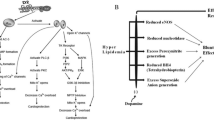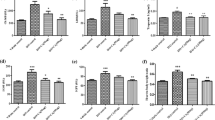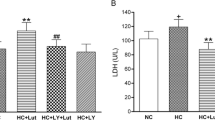Abstract
Hyperlipidemia is regarded as independent risk factor in the development of ischemic heart disease, and it can increase the myocardial susceptibility to ischemia-/reperfusion (I/R)-induced injury. Hyperlipidemia attenuates the cardioprotective response of ischemic preconditioning (IPC). The present study investigated the effect of zinc supplements in the attenuated cardioprotective effect of ischemic preconditioning in hyperlipidemic rat hearts. Hyperlipidemia was induced in rat by feeding high-fat diet (HFD) for 6 weeks then the serum lipid profile was observed. In experiment, the isolated Langendorff rat heart preparation was subjected to 4 cycles of ischemic preconditioning (IPC), then 30 min of ischemia followed by 120 min of reperfusion. Myocardial infarct size was elaborated morphologically by triphenyltetrazolium chloride (TTC) staining and biochemically by lactate dehydrogenase (LDH) and creatine kinase-MB (CK-MB) release from coronary effluent and left ventricular collagen content. However, the effect of zinc supplement, i.e., zinc pyrithione (10 μM) perfused during reperfusion for 120 min, significantly abrogated the attenuated cardioprotective effect of ischemic preconditioning in hyperlipidemic rat heart whereas administration of chelator of this zinc ionophore, i.e., N,N,N′,N′-tetrakis(2-pyridylmethyl)ethylene diamine (TPEN; 10 μM), perfused during reperfusion 2 min before the perfusion of zinc pyrithione abrogated the cardioprotective effect of zinc supplement during experiment in hyperlipidemic rat heart. Thus, the administration of zinc supplements limits the infarct size, LDH, and CK-MB and enhanced the collagen level which suggests that the attenuated cardioprotective effect of IPC in hyperlipidemic rat is due to zinc loss during reperfusion caused by ischemia/reperfusion.







Similar content being viewed by others
References
Allain CC, Poon LS, Chan CS, Richmond W, Fu PC (1974) Enzymatic determination of total serum cholesterol. Clin Chem 20:470–475
Antman EM, Braunwald E (1997) Acute myocardial infarction. In: Braunwald E (ed) Heart disease, a textbook of cardiovascular medicine, 5th edn. WB Saunders & Co, Philadelphia, pp 1184–1188
Bray TM, Bettger WJ (1990) The physiological role of zinc as an antioxidant. Free Radic Biol Med 8:281–291
Buja LM (2005) Myocardial ischemia and reperfusion injury. Cardiovasc Pathol 14:170–175
Chanoit G, Lee S, Xi J, Zhu M, McIntosh RA, Mueller RA, Norfleet EA, Xu Z (2008) Exogenous zinc protects cardiac cells from reperfusion injury by targeting mitochondrial permeability transition pore through inactivation of glycogen synthase kinase-3β. Am J Physiol 295:H1227–H1233
Chopra K, Singh M, Kaul N, Andrabi KJ, Ganguly NK (1992) Decrease of myocardial infarct size with desferrioxamine: possible role of oxygen free radicals in its ameliorative effect. Mol Cell Biochem 113:71–76
Collard CD, Gelman S (2001) Pathophysiology, clinical manifestation and prevention of ischemic reperfusion injury. Anesthesiology 94:1133–1138
Csont T, Bereczki E, Bencsik P, Fodor G, Gorbe A, Zvara A, Csonka C, Puskas IG, Santha M, Ferdinandy P (2007) Hypercholesterolemia increases myocardial oxidative and nitrosative stress thereby leading to cardiac dysfunction in apoB-100 transgenic mice. Cardiovasc Res 76:100–109
Ferdinandy P (2003) Myocardial ischemia/reperfusion injury and preconditioning: effects of hypercholesterolemia/hyperlipidemia. Br J Pharmacol 138:283–285
Ferdinandy P, Szilvassy Z, Baxter GF (1998) Adaptation to myocardial stress in disease states: is preconditioning a healthy heart phenomenon? Trends Pharmacol Sci 19:223–229
Fishbein MC, Meerbaum S, Rit J, Lando U, Kanmatsuse K, Merair JC, Corday E, Ganz W (1981) Early phase acute myocardial infarct size quantification: validation of the triphenyltetrazolium chloride tissue enzyme staining technique. Am Heart J 101:593–600
Fryer RM, Pratt PF, Hsu AK, Gross GJ (2001) Differential activation of extracellular signal regulated kinase isoforms in preconditioning and opioid-induced cardioprotection. J Pharmacol Exp Ther 296:642–649
Giricz Z, Lalu MM, Csonka C, Bencsik P, Schulz R, Ferdinandy P (2006) Hyperlipidemia attenuates the infarct size-limiting effect of ischemic preconditioning: role of matrix metalloproteinase-2 inhibition. J Pharmacol Exp Ther 316:154–161
Hausenloy DJ, Duchen MR, Yellow DM (2003) Inhibiting mitochondrial permeability transition pore opening at reperfusion protects against ischemia-reperfusion injury. Cardiovasc Res 60:617–625
Hoshida S, Yamashita N, Igarashi J, Nishida M, Hori M, Kuzuya T, Tada M (1996) A nitric oxide donor reverses myocardial injury in rabbits with acute hypercholesterolemia. J Pharmacol Exp Ther 278:741–746
Iliodromitis KE, Lazou A, Kremastinos DT (2007) Ischemic preconditioning: protection against myocardial necrosis and apoptosis. Vasc Health Risk Manag 3:629–637
Jamall IS, Finelli VN, Que Hee SS (1981) A simple method to determine nanogram levels of 4-hydroxyproline in biological tissues. Anal Biochem 112:70–75
Jung O, Jung W, Malinski T, Wiemer G, Schoelkens BA, Linz W (2000) Ischemic preconditioning and infarct mass: effect of hypercholesterolemia and endothelial dysfunction. Clin Exp Hypertens 22:165–179
Karagulova G, Yue Y, Moreyra A, Boutjdir M, Korichneva I (2007) Protective role of intracellular zinc in myocardial ischemia/reperfusion is associated with preservation of protein kinase C isoforms. J Pharmacol Exp Ther 321:517–525
Katakam PVG, Jordan JE, Snipes JA, Tulbert CD, Miller AW, Busija DW (2007) Myocardial preconditioning against ischemia-reperfusion injury is in Zucker obese rats with insulin resistance. Am J Physiol Regul Integr Comp Physiol 292:920–926
Kurose I, Argenbright LW, Anderson DC, Tolley J, Miyasaka M, Harris N, Granger DN (1997) Reperfusion-induced leukocyte adhesion and vascular protein leakage in normal and hypercholesterolemia rats. Am J Physiol 273:H854–H860
Little PJ, Bhattacharya R, Moreyra AE, Korichneva IL (2010) Zinc and cardiovascular disease. Nutrition 26:1050–1057
McIntosh R, Lee S, Ghio AJ, Xi J, Zhu M, Shen X (2010) The critical role of intracellular zinc in adenosine A2 receptor activation induced cardioprotection against reperfusion injury. J Mol Cell Cardiol 49:41–47
Murry CE, Jennings RB, Reimer KA (1986) Preconditioning with ischemia: a delay of lethal cell injury in ischemic myocardium. Circulation 74:1124–1136
Nakamura M, Wang NP, Zhao ZQ, Wilcox JN, Thourani V, Guyton RA, Vinten-Johansen J (2000) Preconditioning decreases Bax expression, PMN accumulation and apoptosis in reperfused rat heart. Cardiovasc Res 45:661–670
Ohara Y, Peterson TE, Sayegh HS, Subramanian RR, Wilcox JN, Harrison DG (1995) Dietary correction of hypercholesterolemia in the rabbit normalizes endothelial superoxide anion production. Circulation 92:898–903
Onody A, Csonka C, Giricz Z, Ferdinandy P (2003) Hyperlipidemia induced by a cholesterol-rich diet leads to enhanced peroxynitrate formation in rat hearts. Cardiovasc Res 58:663–670
Parikh V, Singh M (1999) Possible role of adrenergic component and cardiac mast cell degranulation in preconditioning induced cardioprotection. Pharmacol Res 40:129–137
Puskas LG, Nagy ZB, Giricz Z, Onody A, Csonka C, Kitajka K (2004) Cholesterol diet induced hyperlipidemia influences gene expression pattern of rat hearts: a DNA microassay study. FEBS Lett 562:99–104
Sharma A, Singh M (2000) Possible mechanism of cardioprotective effect of ischaemic preconditioning in isolated rat heart. Pharmacol Res 41:635–640
Sharma NK, Mahadevan N, Balakumar P (2013) Adenosine transport blockade restores attenuated cardioprotective effects of adenosine preconditioning in the isolated diabetic rat heart: potential crosstalk with opioid receptors. Cardiovasc Toxicol 13:22–32
Tyagi P, Tayal G (2002) Ischemic preconditioning of myocardium. Acta Pharmacol Sin 23:865–870
Ungi I, Ungi T, Ruzsa Z, Nagy E, Zimmermann Z, Csont T, Ferdinandy P (2005) Hypercholesterolemia attenuates the anti-ischemic effect of preconditioning during coronary angioplasty. Chest 128:1623–1628
Wang Y, Kado M, Xu M, Ayub A, Ashraf M (2001) Mitochondrial KATP channel as an end effector of cardioprotection during late preconditioning: triggering role of nitric oxide. J Mol Cell Cardiol 33:2037–2046
Wang TD, Chen WJ, Seh-Yi SS, Lo SC, Lin WW, Lee YT (2002) Increased cardiomyocyte apoptosis following ischemia and reperfusion in diet induced hypercholesterolemia: relation of Bcl-2 and Bax proteins and caspase-3 activity. Lipids 37:385–394
Werner M, Gabrielson DG, Eastman J (1981) Ultramicro determination of serum triglycerides by bioluminescent assay. Clin Chem 27:268–271
Xu Z, Kim S, Hua J (2014) Zinc plays a critical role in the cardioprotective effect of postconditioning by enhancing the activation of the RISK pathway in rat hearts. J Mol Cell Cardiol 66:12–17
Acknowledgments
Authors are thankful to the management and teaching faculty of ISF College of Pharmacy, Moga, India, for providing requisite facilities.
Conflict of interest
Authors declare no conflict of interest.
Author information
Authors and Affiliations
Corresponding author
Rights and permissions
About this article
Cite this article
Kansal, S.K., Jyoti, U., Sharma, S. et al. Effect of zinc supplements in the attenuated cardioprotective effect of ischemic preconditioning in hyperlipidemic rat heart. Naunyn-Schmiedeberg's Arch Pharmacol 388, 635–641 (2015). https://doi.org/10.1007/s00210-015-1105-6
Received:
Accepted:
Published:
Issue Date:
DOI: https://doi.org/10.1007/s00210-015-1105-6




